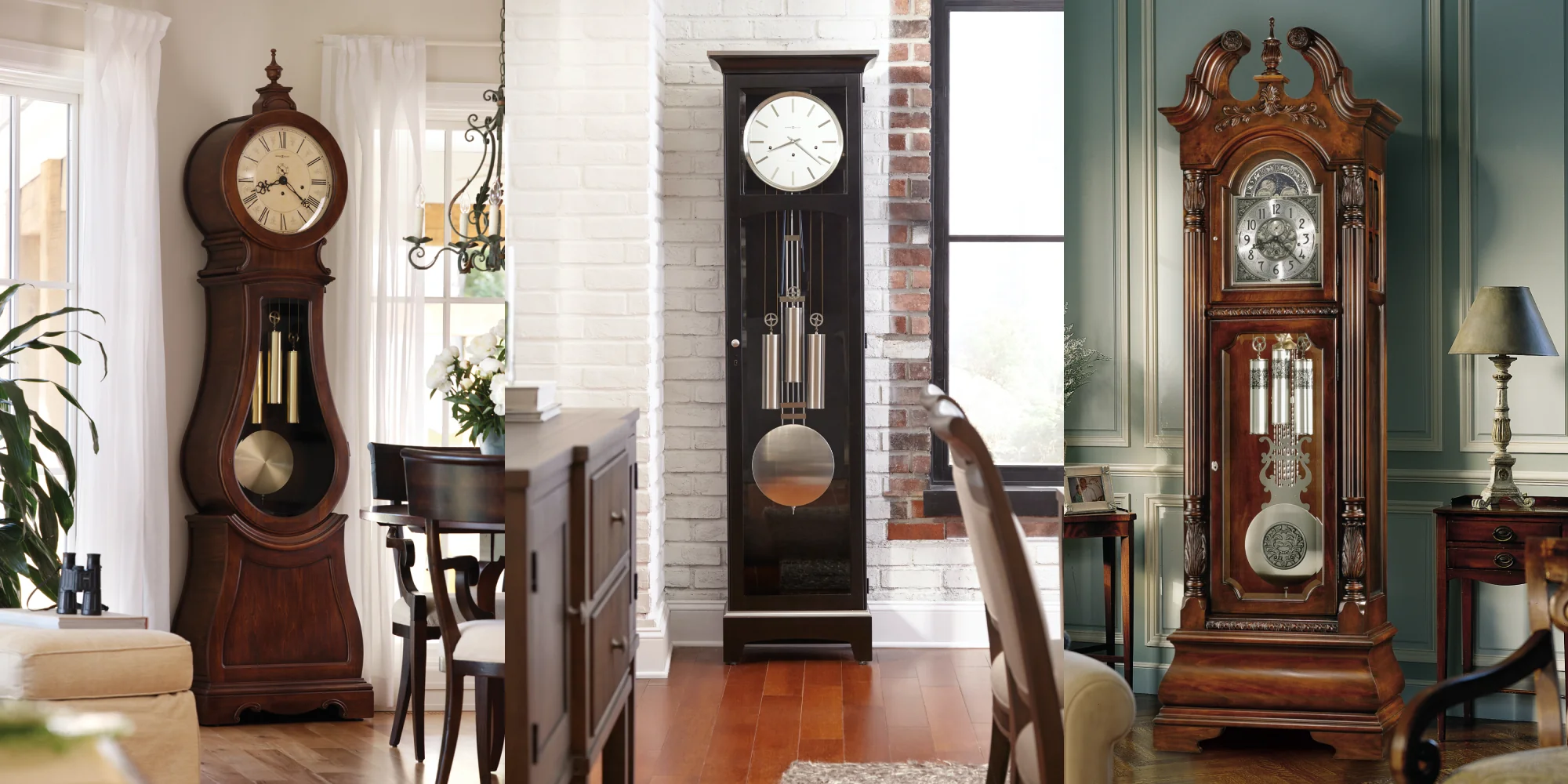In the world of horology, few timepieces command the same respect and admiration as the grandfather clock. With its towering presence and intricate craftsmanship, the grandfather clock has been a symbol of tradition, precision, and cultural significance for centuries. This article delves into the fascinating history, design, and impact of grandfather clocks, exploring how they have shaped lives and spaces throughout history.
What is a Grandfather Clock?
A grandfather clock, also known as a longcase clock, is a tall, freestanding clock with a pendulum mechanism housed in a long, narrow case. Its distinctive design typically features a pendulum and weights, along with a clock face that displays the time, and sometimes additional features such as moon phases or calendar indicators.
The name “grandfather clock” originated from the popular song “My Grandfather’s Clock,” which was written by Henry Clay Work in 1876. The song’s lyrics about a clock that “stopped short, never to go again” helped cement the term in popular culture.
A Brief History of Grandfather Clocks
The origins of the grandfather clock date back to the late 17th century when the first longcase clocks were made in England. The invention of the pendulum clock by Dutch scientist Christiaan Huygens in 1656 was pivotal in the development of these timepieces, as it allowed for unprecedented accuracy in timekeeping.
Grandfather clocks became increasingly popular throughout the 18th and 19th centuries, particularly in England and America. Their elegant design and reliability made them a prized possession in many households, symbolizing status and a commitment to precision.
The Design and Craftsmanship of Grandfather Clocks
Crafting the Perfect Timepiece: The Anatomy of a Grandfather Clock
The design of a grandfather clock is a testament to both artistry and engineering. Key components include:
- The Case: Typically made from wood, the case of a grandfather clock is tall and slender, standing between six to eight feet in height. It often features elaborate carvings, inlays, and finishes that reflect the craftsmanship of its era.
- The Dial: The clock face or dial displays the time and often includes additional features such as a moon phase indicator or a calendar. The dial may be adorned with intricate artwork or engraving.
- The Pendulum: The pendulum, a swinging rod that regulates the clock’s timekeeping, is housed within the case. Its length and motion are crucial for the clock’s accuracy.
- The Movement: The internal mechanism, or movement, includes gears, weights, and springs that drive the clock’s hands and chimes. The movement is typically made from brass or other durable materials.
The Art of Crafting Grandfather Clocks
The creation of a grandfather clock involves meticulous craftsmanship and attention to detail. Skilled artisans spend hours carving, assembling, and polishing each component to ensure both functionality and beauty. Traditional methods of clockmaking are often used, including handcrafting the movement and case, which adds to the clock’s unique character and value.
Cultural Significance and Historical Impact
Grandfather Clocks in American History
In the American South, especially during the 18th and 19th centuries, grandfather clocks played a significant role in plantation life. These timepieces were not merely functional but also symbolized wealth, status, and the organization of daily life.
- Plantation Life: On plantations, grandfather clocks helped regulate the daily schedule for both the family and the workers. They signaled when it was time to work, eat, and rest, playing a crucial role in managing the rhythm of daily activities.
- Symbol of Authority: For plantation owners and affluent families, the grandfather clock was a status symbol that represented their wealth and social standing. Its presence in a home indicated both financial success and an appreciation for fine craftsmanship.
The Grandfather Clock’s Influence on Social Structure
Grandfather clocks were more than just timekeeping devices; they also had a profound impact on social organization. In the Civil War era South, these clocks helped establish order within households and larger estates, reinforcing the social hierarchy and routines that defined the era.
- Impact on the Working Class: For the working class, the grandfather clock served as a reminder of the rigid schedules and expectations placed upon them. It was a tool for managing work and rest periods, shaping their daily lives.
- Middle-Class Significance: In middle-class homes, the grandfather clock represented a sense of stability and aspiration. It was a mark of success and a way to demonstrate a commitment to tradition and quality.
- Elite Status: Among the elite, the grandfather clock was a symbol of power and sophistication. Its grandeur and craftsmanship were a reflection of their social status and appreciation for fine art.
The Modern Relevance of Grandfather Clocks
Preserving Tradition in a Contemporary World
Despite the advancements in technology and changes in timekeeping, grandfather clocks remain a cherished symbol of tradition and craftsmanship. Many collectors and enthusiasts continue to value these timepieces for their historical significance and aesthetic appeal.
- Antique Collecting: Collectors of antique grandfather clocks seek out these timepieces for their historical value and craftsmanship. Restoring and preserving vintage clocks is a popular hobby, and many collectors view these clocks as heirlooms that can be passed down through generations.
- Modern Adaptations: Some contemporary clockmakers have adapted the traditional design of grandfather clocks to fit modern tastes and technologies. These adaptations may include updated materials, designs, and features while maintaining the classic aesthetic.
The Grandfather Clock in Contemporary Interior Design
In modern interior design, grandfather clocks continue to be a focal point and a conversation starter. They can add a touch of elegance and history to contemporary spaces, blending tradition with modern aesthetics.
- Design Integration: Modern designers often incorporate grandfather clocks into various design schemes, using them as statement pieces or integrating them into traditional and eclectic interiors.
- Customization: Custom grandfather clocks are available, allowing individuals to choose designs, materials, and features that match their personal style and home decor.
Caring for Your Grandfather Clock
Maintenance and Preservation Tips
To ensure that a grandfather clock remains in excellent condition, regular maintenance and care are essential. Here are some tips for preserving your timepiece:
- Regular Cleaning: Dust and clean the clock’s exterior and dial regularly to prevent buildup that can affect its appearance and functionality.
- Professional Servicing: Have the clock serviced by a professional horologist every few years to check the movement, oil the gears, and make any necessary repairs.
- Proper Placement: Place the clock in a stable environment away from direct sunlight, humidity, and extreme temperatures to prevent damage.
- Winding: Follow the manufacturer’s instructions for winding the clock to keep it running smoothly. Over-winding or under-winding can affect its accuracy and performance.
Restoring Antique Grandfather Clocks
Restoring an antique grandfather clock can be a rewarding process, but it requires expertise and attention to detail. Professional restoration services can address issues such as mechanical malfunctions, cosmetic damage, and missing parts, ensuring that the clock is both functional and visually appealing.
Conclusion
The grandfather clock stands as a testament to the artistry, craftsmanship, and cultural significance of traditional timepieces. From its historical roots in the American South to its continued relevance in modern design, the grandfather clock remains a symbol of elegance and precision.
Whether you are a collector, a history enthusiast, or simply someone who appreciates fine craftsmanship, the grandfather clock offers a unique connection to the past. Its timeless design and enduring legacy make it a cherished addition to any home, embodying the rich heritage of horology and the art of timekeeping.







